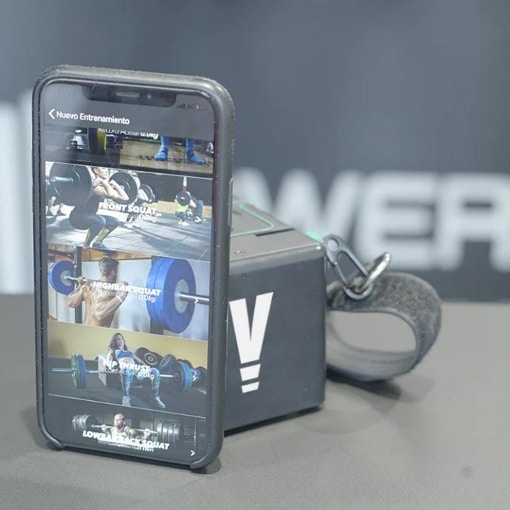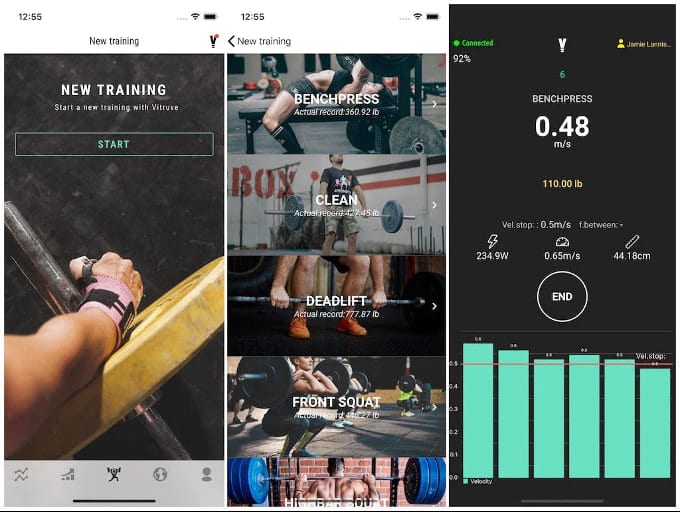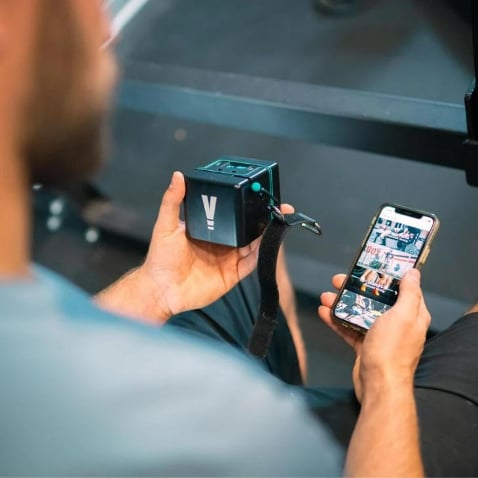9 de May de 2023
The Ultimate Velocity Based Training App
The VBT App

Velocity-based strength training (VBT) is an alternative approach to strength training that has gained increasing attention (research). During VBT, training intensity is controlled by monitoring the concentric velocity of each repetition using devices designed to measure this variable. Until a few years ago, only elite athletes who could afford expensive equipment to perform this type of training could train with this advanced method (Held et al., 2022).
Gradually, however, much cheaper and more useful devices have emerged for strength training. Linear encoders, such as the Vitruve encoder, are as dependable or valid as gold standards, but much cheaper and easier to install and carry when training with athletes (Martinez-Cava et al., 2020; Perez-Castilla et al., 2019). In fact, a few years ago it was unaffordable to get hold of many devices for athletes to train fluently, an aspect that has changed today, and athletes can carry their own velocity meter with them and see their data on the app in real time.
Vitruve’s velocity-based training app is the perfect complement to the velocity-measuring device, as it allows us to see in real time different variables such as velocity, power, range of motion … In the Vitruve velocity-based training app we can also see what our strength-velocity profile is, and quickly get what is the real load to move every day. Surely you have noticed how one day you can move load easily and fast, but a few days later that same load could give you a hard time.
Thanks to Vitruve’s velocity-based training app you can find out what your actual 1RM is on a warm-up lift. You simply add the lifted weight, and the same app which will be synchronized with Vitruve’s velocity measuring device will record the velocity of the lift. Although it would be ideal to have the Vitruve encoder, you can even calculate the barbell velocity manually for free with the Vitruve VBT app.
VBT – Vitruve App
To get the Vitruve VBT App, simply access this link if your system is Android or this link if your system is iOS. Once you have it installed on your mobile or tablet, create your account with an email and password, and after filling in some basic data, you can start measuring the velocity at which you move the bar immediately. To learn how to measure the velocity of the bar step by step with Vitruve’s VBT app, you can read this article in which we explain it in detail.
Roughly speaking, put your cell phone in a place where you can clearly see the lift, jump or movement you are going to analyze. Select the record option in Vitruve’s VBT app, and in that video, you will be able to select the right moment when you start the repetition and when you finish it, which results in the time you have taken to do each repetition.
What are the metrics that I can analyze with Vitruve’s VBT app?
Average velocity: It is the average value of the total velocities in a sum of time. That is, it is the average of the sum of all the instantaneous velocities in a lift.
Fatigue between sets refers to the loss of velocity that occurs from the repetition of the fastest set of the entire training to the repetition of the slowest set.
Average power: the average value of the power applied during a lift.
Advantages of using the VBT app

The main advantage of using the VBT app is that you can do it for free right now. In just a few minutes you will have it on your mobile (link for Android or link for iOS), and you can use it as much as you want and whenever you want. Today all athletes have cell phones, so overnight you will make a leap of quality in your workouts, going from training as usual, to introduce the VBT app to be able to train with this efficient methodology.
Our recommendation is that you dedicate an hour to ask your athletes to download the app on their phones and teach them how to use it. On our YouTube channel we have a free course in which we explain what velocity-based strength training is, what it is used for and how to carry it out, either only with the VBT app, or with the Vitruve velocity measuring device that makes the process much easier. Click here to access the free velocity-based strength course.
After that hour, you will have a lab wherever you train, as every cell phone will be a “pocket lab”. In addition to the advantages of using the VBT app for free, anywhere, and with large groups of athletes, there are all the advantages that velocity-based strength training has in itself (González-Badillo et al., 2022).
Another advantage of the VBT app that may go unnoticed is the athlete’s motivation to move the load faster. When we strength train with an athletic performance goal, it is necessary to move the load with the maximum possible velocity, even if from the outside it looks slow moving if there are many kilograms on the bar. The fact of knowing that after the repetitions are done, we are going to analyze at what velocity we have done them, will be more than enough reason for each repetition to be done at the maximum possible velocity.
Training as Always, Progressing as Never Before
VBT is the most exciting strategy that can be used today to improve strength and conditioning (Dorrell et al., 2020). The way you train profoundly changes little, but those subtle changes will make your athletes progress drastically. By introducing the VBT app, athletes will know each day what their actual 1RM is and will train with the exact load they can move that day. Instead of training with a fixed number of sets, they will do as many sets as their fatigue determines.
One athlete may need three sets and another five to reach the same fatigue. The velocity training app will tell us when we analyze the movement how much velocity we have lost compared to the fastest repetition. Depending on the velocity loss we want to endure, the greater the loss the greater the fatigue, the number of sets will be one or the other (Zhang et al., 2023a).
The velocity training app will also show whether we are progressing or fatigued (González-Badillo et al., 2022). At the end of the warm-up, we will calculate the velocity of movement we are going to train, for example, a squat. To do it correctly, we will choose a high load, but with which we are sure that we will not fail. That will be the fixed weight that we will use every day. If we select one hundred kilos in a back squat, for example, we will measure with the VBT app how fast we have lifted them. If we move them faster than in previous sessions, it is because we are progressing. If we move them more slowly, we should consider whether to train or rest and leave it for another day, as we are fatigued.
All this can be achieved in a few minutes, simply by opening the application in the warm-up, recording the lift we are going to train that day, and analyzing in the VBT app how long it took us to execute it. Depending on the data obtained, we will know if we are improving, we have stagnated, or we are fatigued and need more days of recovery.
Disadvantages When Using a VBT App

In the previous section we have seen all the advantages of using Vitruve’s VBT app. There is a way to get even more out of it: synchronize it with Vitruve’s linear encoder. This technology has come to make our job much easier and do velocity analysis and calculation for us automatically. When using the VBT app we have to measure that travel velocity manually. By having our VBT device, we will have that measurement accurately and automatically.
The VBT app will show us all the information on every repetition we do. This increases the optimization of the training, since it has fewer errors than doing it manually, and we can see within the same series how we lose velocity. This loss of velocity will help us to stop the series when the app warns us that we have lost 20%, 30% or any percentage of velocity with respect to the fastest repetition (Zhang et al., 2023). The motivation to fight against the velocity of the previous repetition will also push the athlete even harder (Weakley et al., 2020).
The VBT app allows to measure the lift with every available cell phone. In encoder is not free like the app, but its price is much lower than other devices, which makes it possible to get several of them if we have an exceptionally large team. Therefore, you can get great advantages for free by using the ultimate Vitruve app to train based on velocity or squeeze even more of those advantages by synchronizing it with the encoder that will do the precise and automatic calculations for us and reflect them on our screens.
Joaquín Vico Plaza
References
González-Badillo, J. J., Sánchez-Medina, L., Ribas-Serna, J., & Rodríguez-Rosell, D. (2022). Toward a New Paradigm in Resistance Training by Means of Velocity Monitoring: A Critical and Challenging Narrative. Sports Medicine – Open, 8(1). https://doi.org/10.1186/S40798-022-00513-Z
Held, S., Speer, K., Rappelt, L., Wicker, P., & Donath, L. (2022). The effectiveness of traditional vs. velocity-based strength training on explosive and maximal strength performance: A network meta-analysis. Frontiers in Physiology, 13. https://doi.org/10.3389/FPHYS.2022.926972
Martínez-Cava, A., Hernández-Belmonte, A., Courel-Ibáñez, J., Morán-Navarro, R., González-Badillo, J. J., & Pallarés, J. G. (2020). Reliability of technologies to measure the barbell velocity: Implications for monitoring resistance training. PLOS ONE, 15(6), e0232465. https://doi.org/10.1371/JOURNAL.PONE.0232465
Pérez-Castilla, A., Piepoli, A., Delgado-García, G., Garrido-Blanca, G., & García-Ramos, A. (2019). Reliability and concurrent validity of seven commercially available devices for the assessment of movement velocity at different intensities during the bench press. Journal of Strength and Conditioning Research, 33(5), 1258–1265. https://doi.org/10.1519/JSC.0000000000003118
Weakley, J., Wilson, K., Till, K., Banyard, H., Dyson, J., Phibbs, P., Read, D., & Jones, B. (2020). Show Me, Tell Me, Encourage Me: The Effect of Different Forms of Feedback on Resistance Training Performance. Journal of Strength and Conditioning Research, 34(11), 3157–3163. https://doi.org/10.1519/JSC.0000000000002887
Zhang, X., Feng, S., & Li, H. (2023). The Effect of Velocity Loss on Strength Development and Related Training Efficiency: A Dose-Response Meta-Analysis. Healthcare (Basel, Switzerland), 11(3). https://doi.org/10.3390/HEALTHCARE11030337

